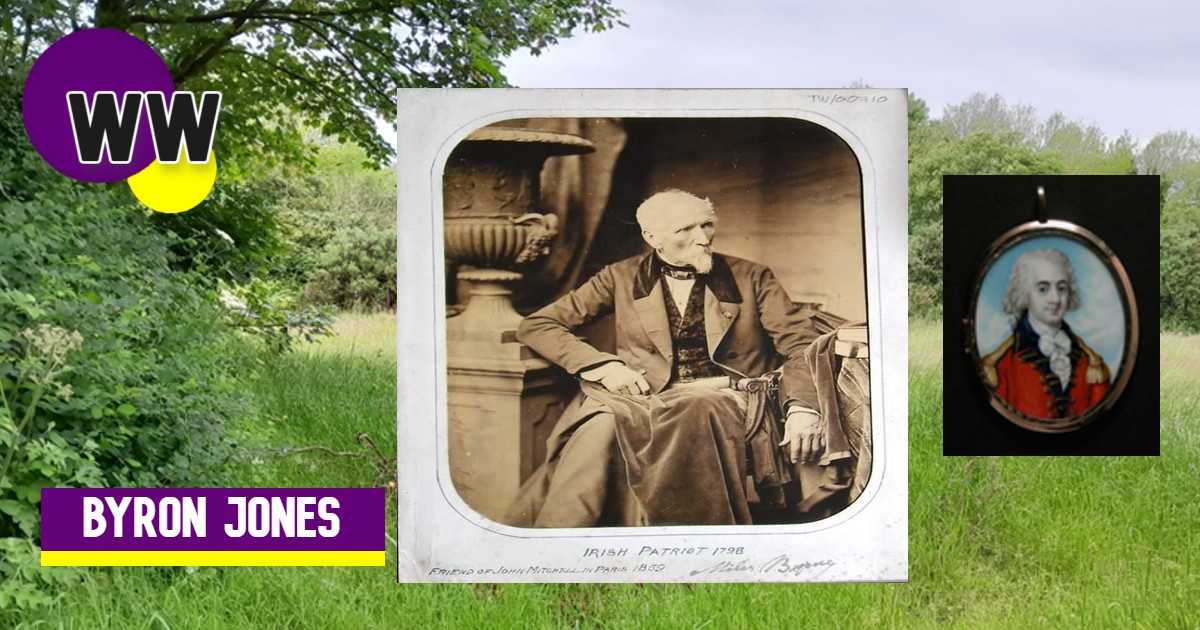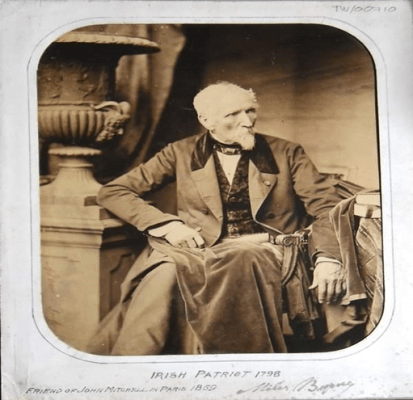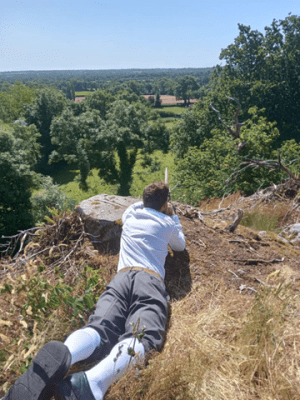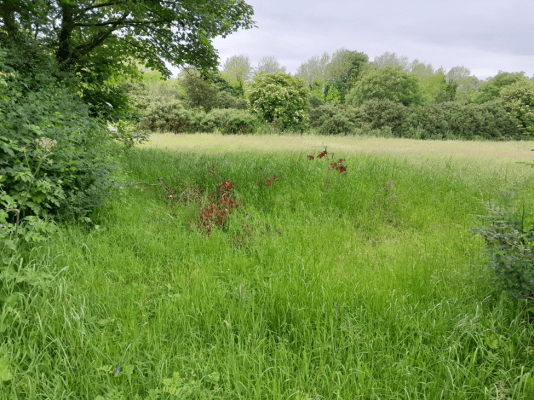
In a peaceful and quiet country area, the townland of Tubberneering, Gorey hosted approximately 45 minutes of chaos and bloody carnage in a 1798 battle that shook the British Government in Ireland…
On June 4th 1798, a detachment of 800 men including the hated Welsh Cavalry unit the Ancient Britions alongside the Suffolk Company, the 4th Dragoon Guards and Armagh Militia amongst others was led by the arrogant Lieutenant-Colonel Walpole into the Tubberneering bends. Their aim was to crush a 10,000 strong Rebel army camped on Carrigrua Hill. Sympathisers on both sides overheard and warned each army of opposing battle plans with the loyalist flung in jail for upsetting the King’s troops and the Rebels taking up their friend’s information and they hatched a plan to surprise the Redcoats with an attack on the road to Gorey, wherever insurgent scouts spotted them.
Walpole was marching his army past Clough when his officers noticed rebels in nearby fields who were advanced scouts. The officers voiced concern to rich the Lieutenant-Colonel exclaimed, ‘I am the commanding officer’ and ordered an organised advance.
Walpole showed both arrogance and inexperience by ignoring the Lieutenants and Colonel’s advice, ignoring Rebels in the fields, and failing to send forth skirmishers or indeed form flanking parties and he was about to pay dearly for these mistakes.
The Rebel vanguard had been notified of The Government troops advancing towards Tubberneering bends by the scouts and took to Tubberneering Rock, a high rocky platform and thus natural area of cover about 200 yards from the road. In addition, many pikemen of the vanguard would have lined the inside of the tall hedgerows beside the road.
Myles Byrne, a Rebel leader from Monaseed, already announcing himself to the insurgent army as a natural military strategist and skilled fighter at the ripe age of only 18, would have probably been amongst them.

The Rebels on the rock were sharpshooters or what we would term a sniper group. One of the men, a young man called Loftus Hatton may have been an Ancestor of mine, but as of yet, we have no way of proving it. Hopefully, he is – because it’s a fantastic story. These sharpshooters were equipped with stolen brown bess muskets from Redcoats at previous Rebel victories, but perhaps some had their own guns too.

The men were backed up by some pikemen along the hedge of the road ready for the ambush to commence.
Walpole rounded the bends and noticed a man with a gun in the middle of the road, but still marched on. Pandemonium quickly ensued as Rebel sharpshooters roared a wild intimidating battle cry and unleashed a thunderous volley of musket balls on the Redcoats and invisible men piked Government troops from behind the high hedges of Tubberneering in tandem.
Warfare in this part of North County Wexford was not for an organised army. The townland was totally favourable to the Wexford men with small fields and high hedges disrupting the usual tactics of British army troops.
With the noise of menacing battle echoing through the area, Father John Murphy and Edward Roche along with thousands of insurgents started rushing from down the road headlong into battle. We can sense the excitable charge from Myles Byrne’s, ( an 18 year old Rebel leader of Monaseed), recollection:
“Nothing could equal the enthusiasm of our line of battle not marching but running to the assistance of our advanced guard,” he recollected.
Soon, the United Irishmen had the Government troops surround on all sides.
Early in the battle, perhaps within 10 minutes, two shots rang out from the rock. A Hatton man’s shot whizzed through the air and excruciatingly hit Walpole in the groin, but thankfully for his sake, he fell off his beautiful grey horse he succumbed to a musket ball to the head from Hatton’s colleague, one Patrick O’Brien.
The protection, height advantage and camouflage / greenery and cover, along with distance from the road meant Tubberneering Rock gave Rebel sharpshooters with their muskets an ideal location. It gave them a fantastic opportunity to wreak havoc in the early stages of the Battle of Tubberneering resulting in the deaths of many Crown soldiers and their leader Lieutenant-Colonel Lambert Theodore Walpole
(Lieutenant-Colonel Lambert Theodore Walpole and a stone Tablet dedicated to his memory, notice it mentions rocks of Sliabh Bui range to exaggerate the difficulty of terrain)
A mad dash by the 4th Dragoon Guards to break Rebel lines on its right flank failed, and it was left to William Watkins Wynne to take on the leadership role for the King’s troops and fought determinedly and organised two six pounder cannons at the Rebel Sharpshooters to good effect.
Fierce fighting broke out in the fields, especially on the right-hand side between the road and the where the railway is now, and in other nearby fields on the east side of the road also, with large-scale pike charges headlong into Redcoat troops.
A memorable sight on the day was the determination, steel, and furious fighting of Colonel Anthony Perry of Inch whose fearsome battle cries on the day earned him the title ‘The Screeching General’.

A battle within the battle raged for the ownership of the Cannon under Wynne, with insurgent infantry gaining but then losing them after a valiant surge by Wynne. Rebels began to tighten the noose on the comparably smaller Government army and again took the two six pounder cannons and a Howitzer field gun.
Many Royal Irish artillery men had been killed, others captured and severely wounded and gorses bolted leaving little further option but for Wynne to eventually abandon them.
The three cannons were soon fired on their previous owners. A quote from a redcoat soldier told the psychological effect this soon had:
‘It was truly painful to behold our cannon on the road useless to us and the groans of our wounded torn by pikes,” the Redcoat soldier said.
An African soldier of Government commented of the retreat, ‘Sare, the Army run away, the Armagh retreat’. The King’s troops had hit the road in a hasty disorganised retreat towards Gorey with Colonel Cope and a small detachment of the Armagh militia allowing many of their comrades stream through before forming a battle line to slow up the Insurgent advance towards the town.

The battle was a resounding Victory for the Wexford Rebels and a huge confidence and moral booster. It was so emphatic that briefly not only did the King’s troops give up Gorey, but also Arklow, many not finding a haven until Wicklow town and some so shocked they didn’t stop till Dublin.
In the newspapers of London and England, news started to filter through. Some in Westminister and the British Army were so shocked that they began to wonder, is there anything stopping Father Murphy’s mighty Insurgent wave from reaching the outskirts of Dublin?
In the immediate aftermath of Tubberneering, the answer was perhaps maybe Wicklow town and that is was, the last line of defence of the British administered Capital of Ireland.
Myles Byrne captured the moment:
‘The result of the days fighting was incalculable for our cause, to see such numbers of fine fellows rush into the greatest danger for Love of their country and it’s independence’.
The battle of Tuberneering, June 4th 1798 was one hell of a schmozzle and a huge Rebel Victory that shook an Empire and held high the hopes of a free and United Ireland.
As a Graduated Historian and Professional Archaeologist and a local, I get caught up in it – but I always try to see both sides. Hopefully, I have come across that way and the most important thing in 2024, and I think one local woman put it into perspective for me yesterday.
“Thank God those horrible days of open warfare and destruction are over and done with, Glorification of bloodlust should be thrown out the window and we are now thankfully at peace on this Island,” she said.
I then witnessed her wash the memorial stone.
Respect for what these people did but what peaceful, happy and prosperous times we live in now.
Read also:
Remember to submit your news to Wexford Weekly! To advertise on our socials or website, email our team at info@wexfordweekly.com




